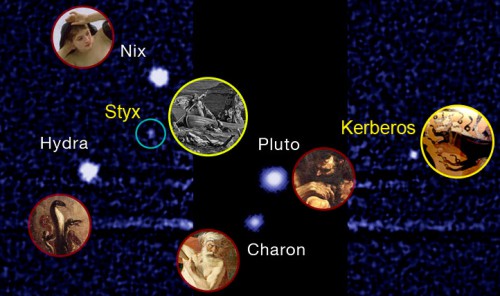
Two of Pluto’s small moons, previously known just as P4 and P5, have been given official names by the International Astronomical Union (IAU). Pluto is the god of the underworld in classical mythology, so P4 has been named Kerberos after the three-headed dog which guarded the entrance to Pluto’s realm, and P5 has been named Styx after the river that the souls of the dead had to cross to reach the underworld. (The ferryman was called Charon—the name of Pluto’s biggest moon.)
Kerberos and Styx were discovered in 2011 and 2012 respectively by Mark Showalter of the SETI Institute using the Hubble Space Telescope in searches specifically aimed at finding if there were any undetected objects in the Pluto system. Such objects could prove hazardous to the New Horizons probe, which is due to fly within the orbit of the innermost known moon, Charon, in 2015.
The names of the new-found moons were chosen after a poll conducted by Showalter, in which over 450,000 people took part. The first choice was actually Vulcan, after the fictional planet in the Star Trek universe. But despite endorsements by actors William Shatner and Leonard Nimory, this was rejected by the IAU because Vulcan (god of the forge) isn’t connected to Pluto in mythology, and had also been used for a hypothetical planet once thought to orbit the Sun closer than Mercury. Cerberus came second in the poll but is already the name of an asteroid, so the spelling was changed to Kerberos. Styx was the third most popular choice.
Want to keep up-to-date with all things space? Be sure to “Like” AmericaSpace on Facebook and follow us on Twitter: @AmericaSpace
Missions » New Horizons »




Soooo, the New Horizons spacecraft was lovingly conceived of and created by a close-knit family of devoted, caring engineers who instilled what they knew was best in their creation, and then sent it out into interplanetary space where they we certain it would make them very proud. What will this innocent, eager young spacecraft first encounter? Pluto, the cold, distant, ominous god of the underworld, guarded by Kerebros a vicious three-headed dog like a rabid pit bull from Hell and Hydra, a nine-headed serpent that re-grows a head when severed. First, one must cross the river of no return, Styx across which the souls of the dead are ferried by the foreboding boatman Charon the child of Nix, goddess of darkness and night. Poor New Horizons. Even Mars has Phobos “Fear” and Deimos “Terror”. Geez, aren’t there any moons named “Fluffy”, “Butterfly”, or “Rainbow”? 🙂
Well, there’s this really lovely and bright-looking planet called Venus, named for the godess of love and beauty, but it turns out that the planet itself is an acidic hell-more like Dante’s Inferno! 🙂
You’re right Leonidas, and once again with gratitude to our Greek brothers who did so much to lay the foundation for our western civilization, we have Selene – our very own Moon. As described by Homer in “Hymn to Selene”, Selene is “exceedingly lovely amongst the deathless gods” who “with the light of her golden crown . . . having bathed her lovely body in the waters of the Ocean” drives her silver chariot with two winged snow-white horses across the sky. Quintus Smyrnaeus wrote in “The Fall of Troy” that “Selene watched him [Endymion] from on high, and slid from heaven to earth; for passionate love drew down the immortal stainless Queen of Night.” Oh yeah, I’m probably being chauvinistic, but screw lassoing an asteroid, we REALLY need to go back to the Moon! Let’s see, lifeless, airless chunk of iron, nickel, and rock (hey, if you need iron, Detroit may soon go bankrupt and there will be more than enough scrap iron for everyone)or one “exceedingly lovely amongst the deathless gods.” Hmmm . . . tough choice. 🙂